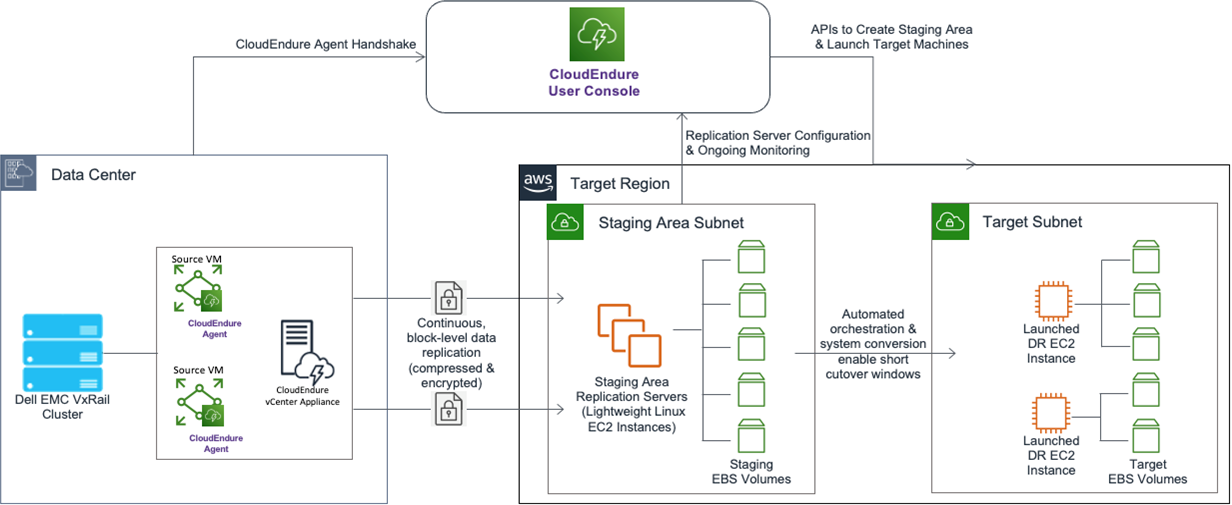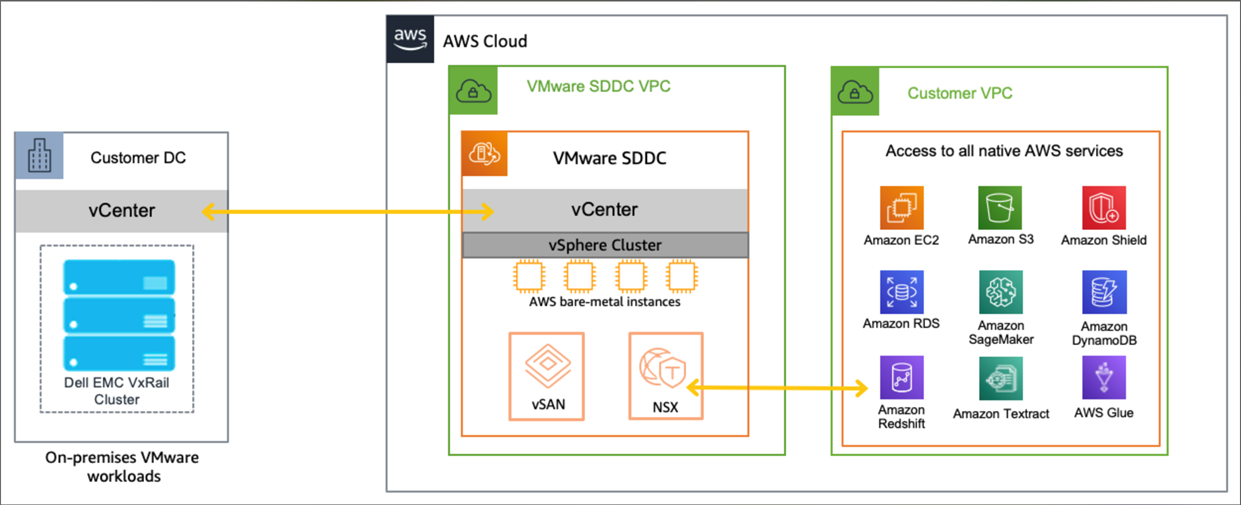AWS Partner Network (APN) Blog
Enabling Connectivity Between Dell EMC VxRail and AWS
By Sailesh Kadam, Solutions Architect – AWS
By Tyler Geary, Solutions Architect – AWS
 |
| Dell Technologies |
 |
Customers across industries leverage hyperconverged infrastructure (HCI) in the form of Dell EMC VxRail in their datacenters in order to centralize their servers, storage area networks (SANs), and shared storage into server-based appliances.
Amazon Web Services (AWS) offers several services and tools that existing Dell EMC VxRail customers can utilize to create a hybrid cloud infrastructure, or accelerate migrations with AWS.
In this post, we will review the AWS native offerings and architectures that can be used to connect Dell EMC VxRail clusters to AWS, including CloudEndure, VMware Cloud on AWS, and AWS Storage Gateway. We will also provide guidance around when to use these options.
Dell Technologies is an AWS Partner that helps customers make the most of their AWS investment with data protection, data management, and data mobility.
CloudEndure Disaster Recovery/Migration
CloudEndure minimizes downtime and data loss with fast, reliable recovery of on-premises and cloud-based applications using affordable storage, minimal compute, and point-in-time-recovery.
Customers can use CloudEndure Disaster Recovery to perform a disaster recovery (DR) failover and failback. Because Dell EMC VxRail leverages VMware vCenter, customers can use the native vCenter integration features of CloudEndure Disaster Recovery. This provides the ability to orchestrate failover and failback of multiple virtual machines (VMs) automatically, without having to install failback agents on individual VMs after a DR event has occurred.
CloudEndure Disaster Recovery performs block signature comparison before initiating data replication to verify duplicate or empty blocks aren’t sent across the network in addition to encryption and compression, which results in wide area network (WAN) optimization.
CloudEndure Migration functions in the same way and allows you to simplify, expedite, and automate migrations from physical, virtual, and cloud-based infrastructure to AWS. It automatically converts any application on supported operating systems, which enables full functionality on AWS without compatibility issues. CloudEndure Migration licenses are free and enabled for 90 days from initial activation.
The following diagram explains the architecture for CloudEndure Disaster Recovery/Migration for customers with a Dell EMC VxRail cluster.
Figure 1 – CloudEndure for VMware environments.
VMware Cloud on AWS
VMware Cloud on AWS allows customers to deploy an on-demand cloud service of a VMware software-defined data center (SDDC) that is managed by VMware. This service gives customers the ability to run their applications across VMware vSphere-based cloud environments and seamlessly integrate with native AWS services.
VMware Cloud on AWS is integrated with vSphere, vSAN, and NSX all while allowing customers to use the same vCenter interface they use today. This provides a single management pane using Hybrid Linked Mode (HLM), granting IT teams the ability to manage cloud-based resources with the VMware tools they’re already familiar with.
Built on the AWS global infrastructure, VMware Cloud on AWS is optimized to run on dedicated bare-metal infrastructure and gives customers the scalability and elasticity AWS is known for.
Customers are implementing VMware Cloud on AWS to take advantage of the vast portfolio of services and features that make it easy for them to migrate, protect, and run business applications at scale. The most common use cases are: data center extension, disaster recovery, cloud migration, and building next-generation applications.
Getting started with VMware Cloud on AWS is a simple process with step-by-step guides to deploy a VMware SDDC, jointly engineered by VMware and AWS.
Figure 2 – VMware Cloud on AWS architectural overview.
AWS Storage Gateway
AWS Storage Gateway is a set of hybrid cloud storage services that provide on-premises access to virtually unlimited cloud storage.
Storage Gateway provides a standard set of storage protocols such as iSCSI, SMB, and NFS, which allow you to use AWS storage without rewriting your existing applications. It provides low-latency performance by caching frequently accessed data on premises, while storing data securely and durably in AWS cloud storage services.
Storage Gateway also provides bandwidth optimization by compressing and sending only changed data to AWS. Once in AWS, Storage Gateway provides access to Amazon Simple Storage Service (Amazon S3), which can be used as backup storage for on-premises file shares/application servers, or offloading existing tape backups to AWS.
The following diagram explains the architecture for using AWS Storage Gateway for customers with a Dell EMC VxRail cluster.
Figure 3 – AWS Storage Gateway for VMware environments architecture diagram.
Conclusion
In this post, we discussed various options for enabling connectivity between a Dell EMC VxRail cluster and the AWS Cloud.
- If you are looking for a solution to enable backups from on-premises file shares, application servers, and tape backup solutions to nearly limitless cloud storage, then AWS Storage Gateway will best handle your needs.
- If you are looking to enable optimized access to native AWS services to vSphere workloads while maintaining the management experience that vSphere provides, then VMware Cloud on AWS will best handle your needs.
- If you are looking to enable disaster recovery into AWS for your existing vSphere workloads or migrate vSphere VMs into Amazon Elastic Compute Cloud (Amazon EC2), then CloudEndure will best handle your needs.
Related Information
- Configuring VMware for Storage Gateway
- VMware vCenter Disaster Recovery Using CloudEndure Disaster Recovery
Dell Technologies – AWS Partner Spotlight
Dell Technologies is an AWS Partner that helps customers make the most of their AWS investment with data protection, data management, and data mobility.
Contact Dell Technologies | Partner Overview | AWS Marketplace
*Already worked with Dell Technologies? Rate the Partner
*To review an AWS Partner, you must be a customer that has worked with them directly on a project.



